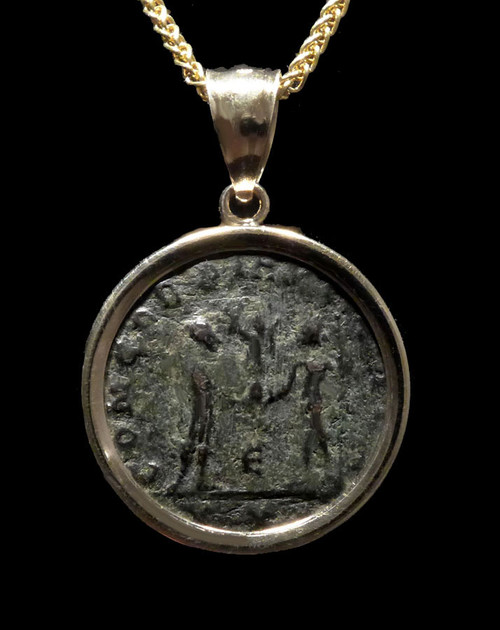Product Description
This ancient Roman bronze coin was minted between 395 A.D. - 408 A.D. during the rule of Arcadius, a descendant of Constantine I (Constantine the Great), the first Christian Roman Emperor. It is set with the reverse side showing a mint condition detailed image of a Roman soldier standing, resting against his spear with the inscription, "Gloria Romanorum" which translates to "The Glory of the Romans". It is set in a high polished 14K yellow gold smooth pendant setting in a unisex design making this pendant equally fitting for wear by either a man or woman.
The coin features superb detail and high relief with a colorful patina. With an inscription 'The Glory of the Romans', this would be a perfect gift for anyone of Italian descent! From a time when the Empire of Rome personified honor, pride and achievement.
ADD THE DISPLAYED MEDIUM ROUND BOX GOLD CHAIN
HISTORY
In the year 395 A.D. when Arcadius was made emperor of the Eastern Roman Empire upon the death of his father, Theodosius I, The Roman Empire was permanently divided into East and West . Theodosius' other son, Honorius was given the Western Roman Empire to rule. There had been both an eastern and a western emperor since the time of Diocletian, but the empire had always been ruled as if it had been one empire with two halves. After 395 A.D., each half took on the character of a separate empire, with the western empire retaining the Latin language and European culture and traditions, while the inhabitants of the eastern empire spoke Greek and adopted a culture combining Greek, Middle Eastern, and North African elements that would later evolve into what is known as today, the Byzantine Roman Empire. Even the organization of the Christian Church took on a different character as you went from west to east in the late ancient world.
Arcadius was married to an intelligent and powerful woman, Eudoxia, who wielded much influence in the politics of the empire and the Church. In an age of increasing violence and chaos, Arcadius died at the palace of Constantinople from illness on May 1, A.D. 408. His son Theodosius II succeeded him on the throne.
 No event in the history of the Western world was probably more pivotal than that of the Christian conversion of the emperor Constantine. Constantine the Great, as he is famously known, was the first ruler of the Roman Empire to convert to Christianity. His conversion resulted from a miraculous event that took place on the battlefield. Constantine was encamped with his army at the Milvian Bridge, heavily outnumbered by the armies of his challenger Maxentius, across the river. The following historical account was recorded at that time by an ancient writer as follows:
No event in the history of the Western world was probably more pivotal than that of the Christian conversion of the emperor Constantine. Constantine the Great, as he is famously known, was the first ruler of the Roman Empire to convert to Christianity. His conversion resulted from a miraculous event that took place on the battlefield. Constantine was encamped with his army at the Milvian Bridge, heavily outnumbered by the armies of his challenger Maxentius, across the river. The following historical account was recorded at that time by an ancient writer as follows:
"Constantine was praying to his father's god, beseeching him to tell him who he was and imploring him to stretch out his right hand to help him in his present difficulties. While he was fervently praying, an incredible sign appeared to him from heaven. (It would be hard to believe his account if it had been told by anyone else. But the victorious emperor long afterwards declared it to the writer of this history -- when I was honored to meet and talk with him and he even confirmed his statement by an oath. Thus, who could doubt him, especially since time has established its truth?)
He said that about noon, when the day was already beginning to decline, he saw with his own eyes the trophy of a cross of light in the heavens, above the sun, and an inscription that said 'Conquer by This' attached to it. Seeing this, he and his army, which followed him on an expedition and witnessed the miracle, were struck with amazement.
"He said that he doubted within himself what importance the vision might hold. He continued to ponder its meaning through until he fell asleep. While sleeping, the Christ of God appeared to him with the same sign he had seen earlier in the heavens. God commanded him to make a likeness of that sign which he had seen in the heavens and to use it as a safeguard in all encounters with his enemies."
Immediately, Constantine placed the sign of Christ on his standards and had it painted on his shields. Constantine won the day with a decisive victory and Maxentius, thrown from the Milvian Bridge, was drowned when the weight of his armor caused him to sink into the mud and ooze at the bottom of the River Tiber. His body was recovered the day after the battle. From this point on, Christianity became the official religion of the Empire and the capitol was moved from Rome to Constantinople (modern day Istanbul, Turkey).
Upon the death of Constantine the Great in 337 A.D., the Empire was divided among his three sons. The eldest son, Constantine II, took most of the Western Europe, the second son, Constantius II, received the entire Eastern Empire and the youngest Constans, ruled Italy and North Africa under the regency of Constantine II.
 US Dollars
US Dollars
 AUD
AUD
 CAD
CAD
 POUNDS STERLING
POUNDS STERLING
















